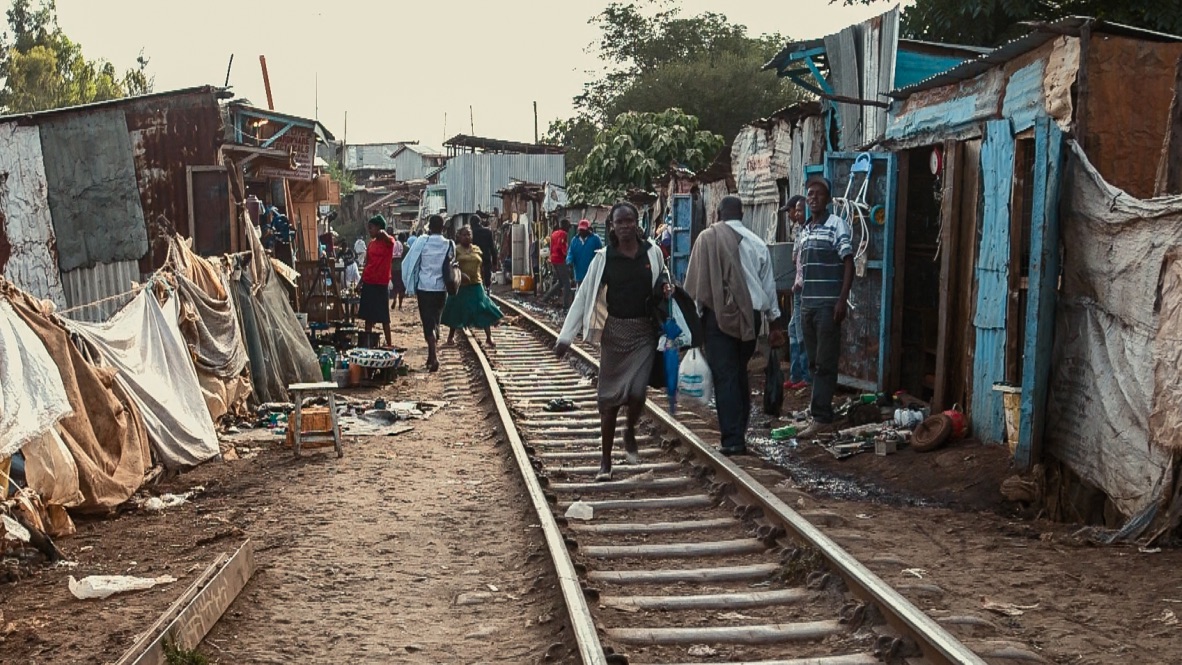The largest slum in Africa, Kibera is home to about 1.2 million people squeezed into an area of about 2.5 square kms. It is estimated that 75% of the slum population is under 18 years old.
Looking out across the roofs of Kibera, the rubbish, in the foreground, is right up against the wall of houses
The homes are a mixture of mud, sticks, concrete and rusted corrugated iron with compacted dirt floors. There is no organised rubbish disposal; it just gets tossed on the mountain of rubbish already there. Sewerage runs down open channels in the mud streets. Rainwater is often collected off the roof to use for cooking and washing, although contaminated by dirt, sewerage, rust and other pollutants.
Kibera housing
The slum is dirty and smelly, especially when it is wet. It is characterised by extreme poverty, contagious diseases, corruption, and sporadic violence. Kibera is not an ideal environment to live in and raise children, but it’s the sad reality when you have so few options.
A typical street in Kibera
There is a railway line running through the slum which is still in use. Kibera and the railway line was featured in the 2005 movie The Constant Gardener. The railway line doubles as a footpath. Many people leave the slum each day to work in the city, returning in the evening. There are numerous cottage industries and stalls set up each day from which to earn a meagre income; shoes, clothing, food, furniture.
The railway line was featured in the 2005 movie The Constant Gardener.
George Odhiambo (below right) is founder and director of the Adventure Pride School that Building for Education is fundraising for. A quiet unassuming man, George lives and works in the slum with his wife and four children. George has a deep commitment to help the slum dwellers, especially the children. Building for Education first met George about 10 years ago, partnering with him to resource another school. The young man walking on the left is Brian, a graduate of that first school. Brian is now qualified as an accountant, and paying it forward by mentoring other children in the slum.
Brian, John Blaiklock from be* and George Odhiambo.
Last month the homes of about 30,000 people were demolished by the government to make way for a link road, with no compensation offered.
The entry to Adventure Pride School prior to being bulldozed, with their tank to collect water
In the classroom you see the real connection between teacher and students, with an eagerness to learn apparent. Education is their only hope of graduating from the slum. Building for Education always works with schools that have a track record. They are already functioning as an entity but need to be better resourced. Since their school was demolished Adventure Pride is meeting in a rented hall but it is only temporary and they need to find a new home urgently.
In the classroom you see the real connection between teacher and students, with an eagerness to learn apparent.
Our recent fundraising efforts have raised over NZ$35,000. This money is earmarked for purchase of land and basic buildings within the slum from which the Adventure Pride School can continue classes. Building for Education is currently working with George to locate and secure a suitable property. Once this initial stage is complete, further funding for development of the school buildings will be the next stage. We aim to raise another $65,000 to contribute toward this. Efforts to secure an education and a future beyond the slum for these children is what drives us.
Building for Education really appreciates the support of everyone who contributed to the recent fundraising effort. As George says, "We can’t change Kibera, but we can change one life at a time, and that will multiply.”







